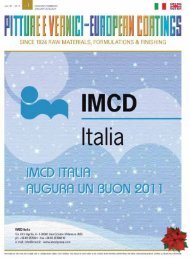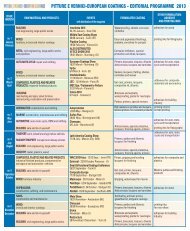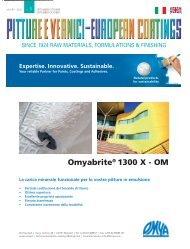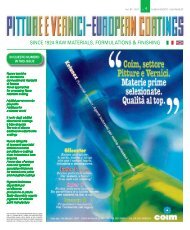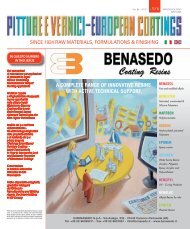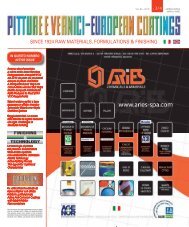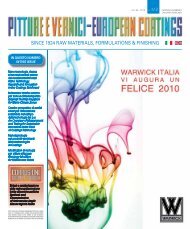since 1924 raw materials, formulations & finishing - PITTURE E ...
since 1924 raw materials, formulations & finishing - PITTURE E ...
since 1924 raw materials, formulations & finishing - PITTURE E ...
Create successful ePaper yourself
Turn your PDF publications into a flip-book with our unique Google optimized e-Paper software.
lisciviazione ne risultano ridotte al minimo.<br />
I conservanti del film ad alta efficacia<br />
agevolano l’industria dei rivestimenti<br />
non solo in Europa, ma anche<br />
negli stati del mondo ad economie<br />
emergenti contribuendo a migliorare<br />
gli standard abitativi.<br />
La conservazione del valore degli immobili<br />
e l’estensione dei cicli di rinnovamento<br />
possono altresì essere<br />
considerati utili ai fini della protezione<br />
dell’ambiente.<br />
BIOCIDES<br />
structure of the layered test specimen. The<br />
algaecide must have been migrated thru the<br />
cross section of the paint film and gets available<br />
at the surface after the paint film layers<br />
were dried. These results are also providing<br />
a hint that the early fate of algaecides can be<br />
controlled by unequipped top coats, which<br />
serve as controlled release layers at the facades.<br />
Outdoor Exposure Results<br />
To proof the concept of superior efficacy of<br />
combined algaecides outdoor exposure studies<br />
have to be performed under several<br />
conditions. Table 6 compares the results of<br />
a outdoor exposure study performed in Germany<br />
in a acrylic paint coated on neutral or<br />
cement based skim coats, respectively,<br />
which were applied on a heat insulation panel.<br />
The algaecides were combined with a<br />
standard fungicide combination of BCM and<br />
L’efficace conservazione ad ampio<br />
spettro del film riveste un’importanza<br />
essenziale ai fini dell’applicazione ef-<br />
OIT (see table 6). Stability, availability and<br />
high broad spectrum activity of algaecides<br />
is necessary to protect the variety of different<br />
coatings in severe environments reliable<br />
from microbial colonization. The experiment<br />
confirmed the concept of algaecide combination<br />
in close to practice conditions.<br />
Conclusions<br />
Experiments demonstrated that understanding<br />
the mechanism of paint film preservation<br />
with highly active substances<br />
BIOCIDI<br />
ASTM D3274 classificazione - esposizione / ASTM D3274 Rating - exposure<br />
Materiale pv / Coating material Substrato / Substrate Alghicida / Algaecide 6 mesi / 6 month 12 mesi / 12 month 18 mesi / 18 month 35 mesi / 35 month<br />
pittura acrilica / acrylic paint cemento / cement BLANK 5 5 2.5 2.5<br />
DMCU 10 10 7.5 5<br />
Mett 7.5 7.5 5 3.8<br />
Mett+IPU 10 10 10 10<br />
neutro/neutral BLANK 5 0 0 0<br />
DMCU 10 7.5 7.5 0<br />
Mett 10 8.8 5 5<br />
p.v. a effetto<br />
Mett+IPU 10 10 10 7.5<br />
textured coating cemento / cement BLANK 0 0 0 0<br />
DMCU 10 10 7.5 7.5<br />
Mett 10 7.5 7.5 5<br />
Mett+IPU 10 10 10 10<br />
neutro/neutral BLANK 0 0 0 0<br />
DMCU 10 10 10 5<br />
Mett 10 10 5 5<br />
Mett+IPU 10 10 10 10<br />
Tab. 6 Esposizione in ambiente esterno dei rivestimenti per sistemi termoisolanti (EIFS) in Germania, studio dell’alghicida. Tutte le finiture sono combinate<br />
con fungicida BCM-OIT. Campione in bianco: nessun conservante del film. (schema valutazione in base a ASTM D3274 (10 = nessuna crescita;<br />
0 = crescita massiccia di microrganismi) – Mett = Terbutryn / Outdoor exposure of coatings for heat insulating systems (EIFS) in Germany, algaecide<br />
study. All top coats were also equipped with a BCM-OIT fungicide. BLANK: no film preservative. (Rating Scheme according to ASTM D3274 (10 = no<br />
growth to 0 totally overgrown by microorganisms)) – Mett = Terbutryn<br />
ficace dei rivestimenti per edilizia, anche<br />
nelle severe condizioni climatiche<br />
tropicali e semitropicali. Si dimostra<br />
CURRICULUM VITAE<br />
helps to develop broad spectrum antimicrobials<br />
for protection of coatings in use.<br />
The data demonstrate that depletion of<br />
algaecides from paint films could be controlled<br />
by application of several coating<br />
layers with different levels of film preservation.<br />
The algaecides can be captured in the coating<br />
and controlled released to the surface.<br />
Early leaching losses are minimized. Highly<br />
efficient film preservatives help the coatings<br />
industry not only in Europe but also in<br />
the emerging economies of the world to<br />
che la combinazione dei principi attivi<br />
alghicidi migliora l’effetto ad ampio<br />
spettro e l’efficacia a lungo termine.<br />
Dr Wolfgang Lindner è chimico ricercatore presso Max-Planck-Institute for Coal Research in Muelheim, Germania. Studia ingegneria<br />
chimica presso University of Applied Science in Krefeld e chimica organica presso Bochum Ruhr University, dove consegue<br />
il dottorato di ricerca in chimica organica riferita alle molecole biologicamente attive. Nel 1983, intraprende la carriera in<br />
ambito industriale a Riedel-de Haen, a Hoechst Company in Seelze, Germania. Da allora si occupa delle tecnologie dei microbiocidi<br />
per l’industria dei coating, nell’area della ricerca e dello sviluppo e del servizio tecnico in Germania, USA e Tailandia.<br />
Dall’inizio del 2009 è responsabile del reparto tecnologie presso Troy Corporation in Asia, Bangok, Tailiandia. Wolfgang Lindner<br />
fa parte del gruppo ricerca internazionale sul tema del biodeterioramento (IBRG), ASTM comitato A01.28 e dell’associazione<br />
tedesca per la chimica (GdCh), è titolare di vari brevetti, autore di relazioni tecniche e di recensioni nel campo dei microbiocidi<br />
per applicazioni tecniche.<br />
Dr Wolfgang Lindner was trained as a research chemist at Max-Planck-Institute for Coal Research in Muelheim, Germany, then<br />
he studied Chemical Engineering at the University of Applied Science in Krefeld and Organic Chemistry at Bochum Ruhr University,<br />
where he earned his PhD in Organic Chemistry of biologically active molecules. In 1983, he started his industrial career at<br />
Riedel-de Haen, a Hoechst Company in Seelze, Germany. Since then he is working on the technology of microbicides for the coatings<br />
industry in research and development, as well as technical service positions in Germany, USA and Thailand. Since early 2009<br />
he is responsible for Technology at Troy Corporation in Asia, based in Bangkok, Thailand. Wolfgang Lindner is a member of the<br />
International Biodeterioration Research Group (IBRG), ASTM – committee A01.28 and the German Association of Chemists (Gd-<br />
Ch), Wolfgang Lindner is the author of numerous Patents, Technical Papers and Reviews in the field of microbicides for technical<br />
applications including the chapter “Surface Coatings” in W.Paulus, Directory of Microbicides<br />
contribute to improvement of housing standards.<br />
The conservation of property value<br />
and extending the renovation cycles can also<br />
considered a contribution to protect the<br />
environment.<br />
Efficient broad spectrum film preservation<br />
is of high importance to allow application<br />
of cost efficient masonry coatings applied<br />
under severe tropical and semi-tropical climates.<br />
It is shown that the combination of algaecidal<br />
active substances improve the broad<br />
spectrum and long term effect.<br />
Pitture e Vernici - European Coatings • 7-8 / 2010<br />
31




